The diverse and rich fabric of Latin music is characterized by its unique chord progressions.
The inherent rhythmic vitality of these progressions captures the attention of listeners and demands to be tapped, swayed, or danced to.
Incorporating these elements into your own compositions can prove to be a transformative experience.
This article will aim to shed some light on these timeless musical constructs, with the potential to lend your music an unforgettable character.
Novices and seasoned composers alike may find comparative insights into these fascinating chord progressions.
Table of Contents
- Latin Chord Progressions
- ii-V-I (2-5-1)
- I-IV-V (1-4-5)
- I-vi-IV-V (1-6-4-5)
- I-IV-ii-V (1-4-2-5)
- vi-ii-V-I (6-2-5-1)
- IV-V-I (4-5-1)
- ii-IV-V-I (2-4-5-1)
- IV-I-ii-V (4-1-2-5)
- vi-V-IV-iii (6-5-4-3)
- i-VII-VI-V (1-7-6-5)
- I-IV-V (1-4-5)
- I-vi-ii-V (1-6-2-5)
- vi-IV-I-V (6-4-1-5)
- I-ii-V7-I (1-2-5-1)
- vi-IV-I-V (6-4-1-5)
- I-IV-V-IV (1-4-5-4)
- IV-V-vi-I (4-5-6-1)
- The Bottom Line
Latin Chord Progressions
ii-V-I (2-5-1)
A classic progression infusing Latin vibes into groovy melodies.
The ii-V-I chord progression is a foundational sequence used frequently in Latin music; its simple, yet catchy structure brings a distinctive rhythmical style that can add a significant flavor to a song. This particular progression, often seen in jazz, is popular due to its cyclic nature, which provides a satisfying resolution and lends itself well to improvisation.
- Difficulty: Intermediate
- Example: Am – D – G (Key of G major)
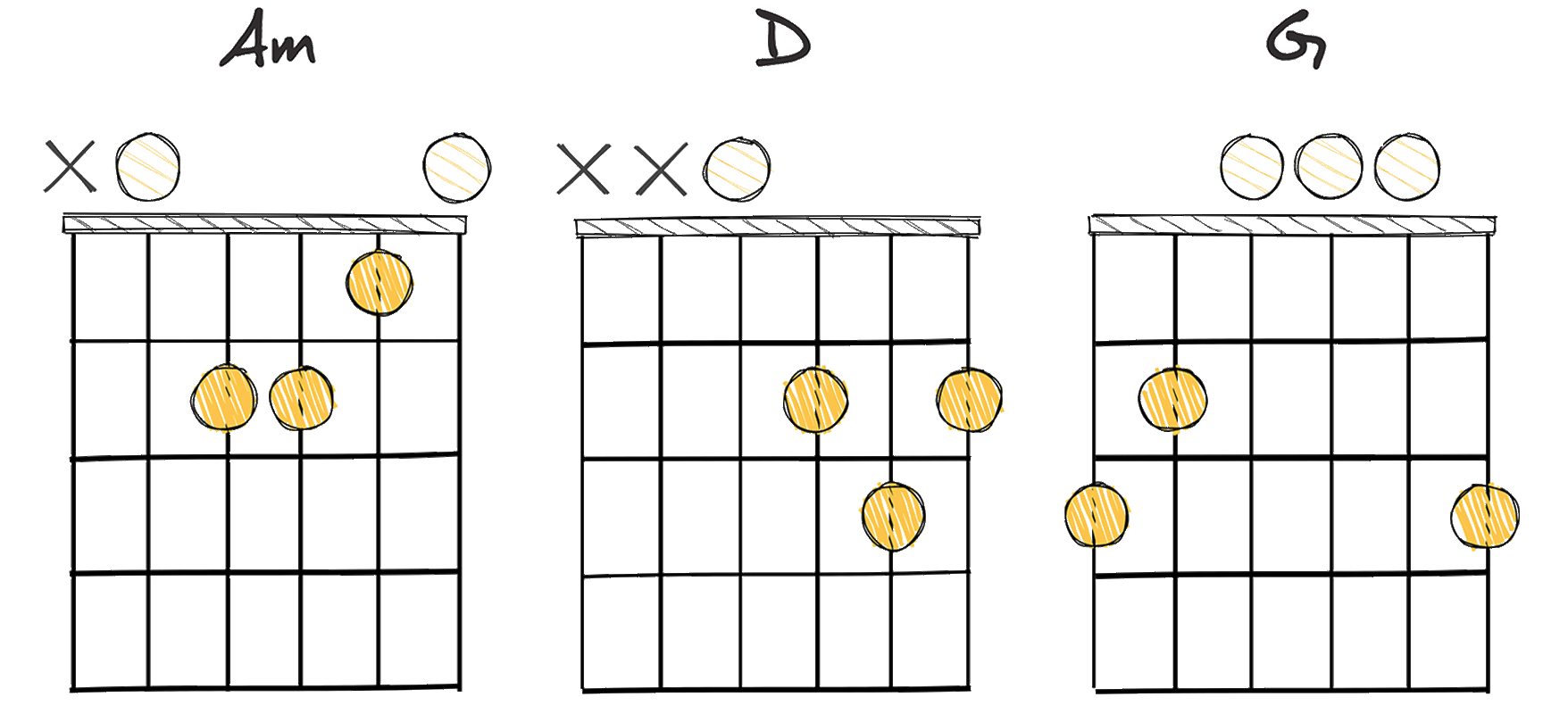
When we delve into the realm of Latin chord progressions, one of the most common and integral is the ii-V-I progression.
Often used in jazz, this sequence has found its way into many Latin genres, adding a unique flavor and tone.
The ii-V-I progression, also known as the 2-5-1, is not only a vital aspect of Latin music but can also be found in different genres like pop, rock, and classical.
It consists of three chords: the second (II or ii), fifth (V or v), and first (I) based on the major scale.
One thing to note about the ii-V-I progression is its inherent sense of “tension and release”.
This is typically created by progressing from a minor chord (ii) to a dominant chord (V), eventually resolving to a major chord (I).
The musical journey of a 2-5-1 is a pursuit of resolution, one that introduces and resolves tension in a satisfying and expressive manner.
In the context of the mentioned statement, the second chord (the V chord) introduces a musical dissonance or tension, akin to a question being posed.
The first chord (the I chord) then provides the final, harmonious answer – the resolution.
This tension and eventual release create a cyclical melodic pattern and natural flow that makes the ii-V-I progression inherently rhythmic, fostering a cadence that is authentically unique to Latin music.
As for the playing difficulty of this progression, it is generally considered to be at an intermediate level.
While not extremely complex, the change of chords does require a certain level of familiarity and practice, especially in faster-paced songs.
The ii-V-I progression is an essential aspect of Latin music, contributing to the genre’s distinctive sound, rhythm, and harmony.
The intricate dance of tension and release this progression provides contributes to Latin music’s feeling, depth, and richness.
The understanding and mastery of this progression enhance your music understanding and add a dynamic layer to your musical compositions and performances.
I-IV-V (1-4-5)
Classic Latin progression fueling energetic rhythms and warm melodies.
The I-IV-V progression, also known as 1-4-5, is a classic chord sequence found in Latin music that provides a rhythmic and harmonious framework. Utilizing this progress, musicians can inject a sense of energy and dynamism into their compositions, adding a distinctive ‘Latin’ flavor to their music.
- Difficulty: Easy
- Example: G – C – D (Key of G major)
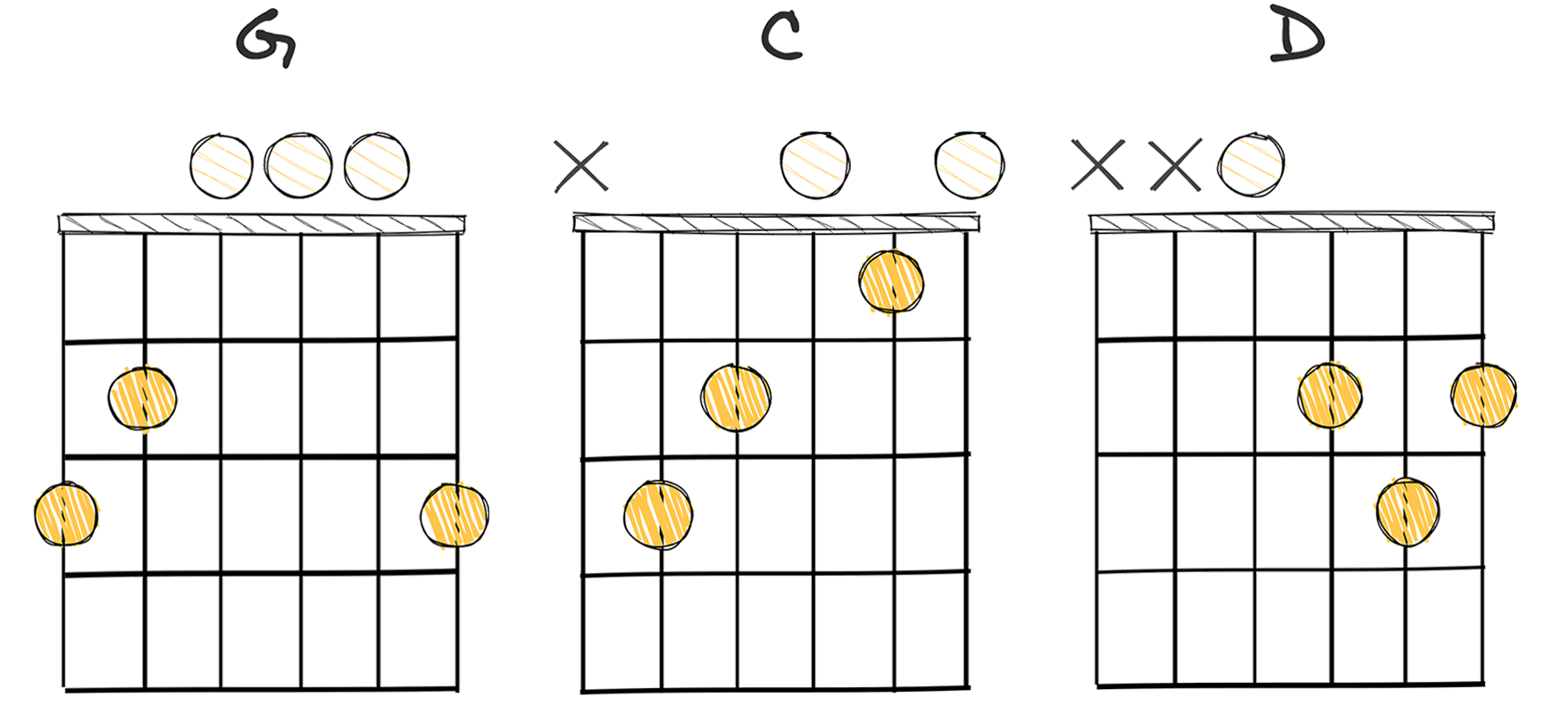
The I-IV-V (1-4-5) chord progression is one of the most elementary structures in popular music, celebrated for its simplicity and versatility.
Enjoying a long history among Latin American performers and their worldwide audiences, this progression has grounded countless compositions in a variety of genres.
In its most basic interpretation, the progression is comprised of the tonic, or “home” chord (I), followed by the subdominant (IV) and the dominant (V) chords.
These three building blocks are so important because they form the harmonic foundation of the key, providing a clear, easy-to-follow path for melody and improvisation.
The simplicity of the I-IV-V progression lends it adaptability, making it easy to play as well as highly recognizable to listeners.
Moreover, it serves as a fantastic launchpad for musicians, particularly those just beginning their journey in understanding music theory and composition.
A testament to the progression’s significance and popularity can be found in its prevalence across a spectrum of genres, including rock, pop, country, and, of course, Latin music.
The I-IV-V progression’s strength lies in its straightforward structure and its remarkable flexibility across different musical styles.
Its rich history within Latin and popular music, coupled with its engaging simplicity, makes it an essential tool for musicians, composers and music enthusiasts alike.
As we delve deeper into other chord progressions, it will become evident just how versatile and influential a few well-chosen chords can be.
I-vi-IV-V (1-6-4-5)
A classic Latin progression, adding fiery passion to your melodies.
The I-vi-IV-V progression is a harmonic sequence common in Latin music, known for delivering a lively and upbeat flavor. It typically starts with a major key (I), followed by its relative minor (vi), leading to the subdominant fourth (IV), and resolves harmoniously to the dominant fifth (V), creating an appealing tension and release cycle.
- Difficulty: Easy
- Example: G – Em – C – D (Key of G major)
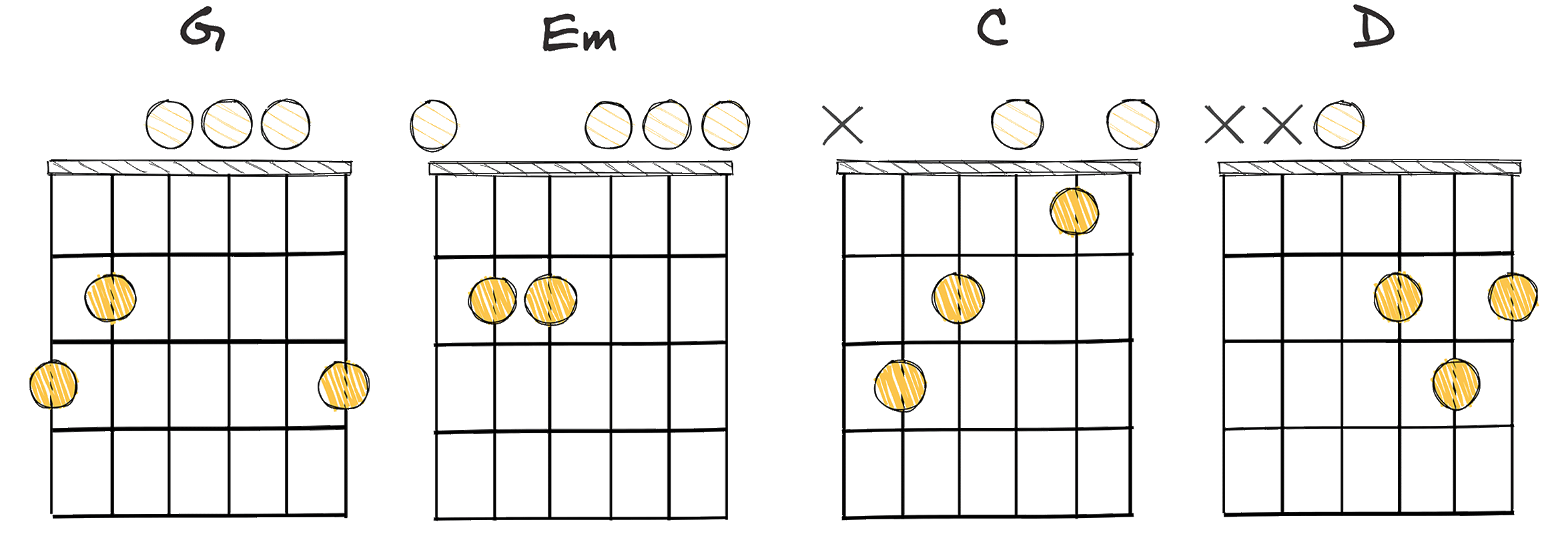
One of the most popular chord progressions used in Latin music is the I-vi-IV-V progression, commonly known as the 1-6-4-5 progression.
Apart from Latin music, the 1-6-4-5 progression has also seen widespread use across multiple genres throughout history, making it not only one of the most beloved chord progressions in Latin music, but in music in general.
Its popularity could be attributed to its ease to play on many instruments, offering a pleasing balance between consonance and dissonance, and the multitude of musical possibilities it provides.
In the key of G major, for example, the chords would be G – Em – C – D.
This element of simplicity makes it an ideal choice for composers and musicians seeking to create a pleasing, melodious sound without the need for complex chord changes.
This framework nature of the progression is likely why it has found its way into countless popular songs across a variety of genres, not just Latin music.
The progression’s ability to create a seamless, cyclical musicality might explain why it continues to hold such a prominent position in music composition, despite its simplistic structure.
Despite being popularly used in modern music, this progression’s history extends back several centuries, featuring prominently in classical music and folk songs as well.
The progression’s connection to ’50s progression’ or ‘doowop- progression’ is another interesting facet of its history that shows its versatility and widespread acceptance.
Quite clearly, the I-vi-IV-V chord progression is a classic, beloved piece of musical structure that transcends genre and period, lending itself effortlessly to innovation and adaptation.
I-IV-ii-V (1-4-2-5)
A dynamic progression infusing zest and vibrant Latin flair.
The I-IV-ii-V chord progression, common in Latin music, offers a beautiful cadence yet keeps a sense of unresolved tension that naturally leads the progression back to the starting point, making cycles seamless and engaging. It adds a spicy, rhythmic flavor to any composition, bringing an unmistakable Latin essence that will surely enchant the audience.
- Difficulty: Intermediate
- Example: D – G – Em – A (Key of D major)
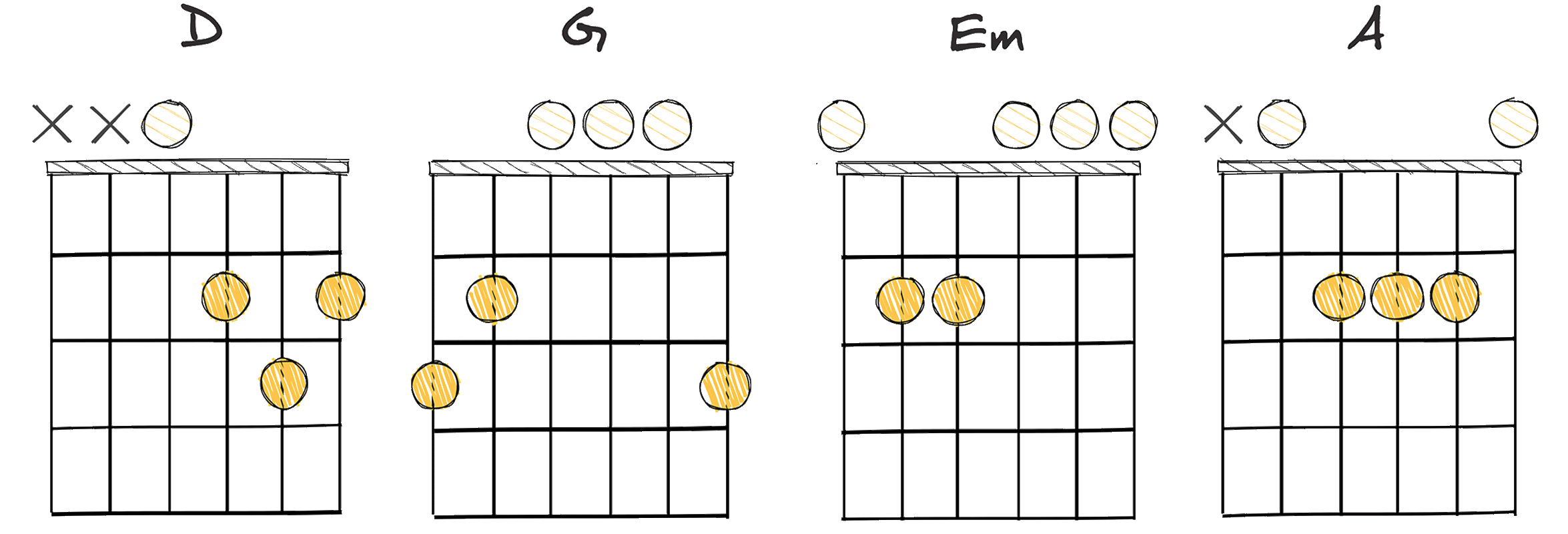
When delving into the core of Latin music, one cannot overlook the importance of the chord progression I-IV-ii-V (1-4-2-5).
This progression has unmistakably helped shape the sound of Latin genres into what we know and love today.
Historically, the I-IV-ii-V progression rose to prominence as Latin music began to intersect with American jazz in the mid-20th century.
It was during this era that Latin music adopted various jazz elements, including innovative chord progressions that became integral to its distinct sound.
The I-IV-II-V progression, in particular, was a game-changer for Latin musicians.
This progression, consisting of the first, fourth, second, and fifth notes of a major scale, offers a rich harmonic palette that composers could use to create the euphonic, rhythmically compelling music that characterizes Latin genres.
Interestingly, the I-IV-ii-V progression is also a mainstay in jazz, noted for its intriguing harmonic journey that never fails to captivate listeners.
Supporting this quote, it’s easy to see that one reason for its popularity could be the complexity it introduces.
In the progression, the chords I and IV establish a sense of tonal center, while the II and V chords shift away from this home key, creating tension that is then beautifully resolved through a return to the I chord.
Through this, a unique ebb and flow is formed, keeping the listener engaged throughout the composition.
Moreover, in a practical sense, the I-IV-ii-V progression is an intermediate level progression that combines familiar and unfamiliar harmonic ideas, thereby allowing musicians to express themselves uniquely while still maintaining a framework that listeners can latch onto.
It is now recognized as a vital piece of the Latin music puzzle, bringing sophistication and an infectious rhythm to tunes.
In terms of guitar, the I-IV-ii-V progression would be translated to D – G – Em – A in the key of D major.
The smooth transition between these chords serves to bring out the passionate and lively spirit intrinsic to Latin music.
The enduring role of the I-IV-ii-V progression in Latin music underlines the genre’s commitment to musical innovation and emotional expression.
As Latin music continues to evolve, we can expect this progression to be used in new and exciting ways, shaping the genre’s future.
In conclusion, whether you are an aspiring musician or a passionate listener, understanding the I-IV-ii-V chord progression is essential to appreciating the rich and dynamic soundscape of Latin music.
vi-ii-V-I (6-2-5-1)
This Latin-infused vi-ii-V-I progression elevates tracks with sultry unpredictability.
This progression, known as vi-ii-V-I or 6-2-5-1, is a widely used chord sequence seen frequently in Latin music styles due to its rhythmic complexity and harmonic richness. It offers a pleasing sense of resolution and has a cyclic nature that keeps pushing the music forward, making it a great tool for spicing up your compositions.
- Difficulty: Intermediate
- Example: G#m – C#m – F# – B (Key of B major)
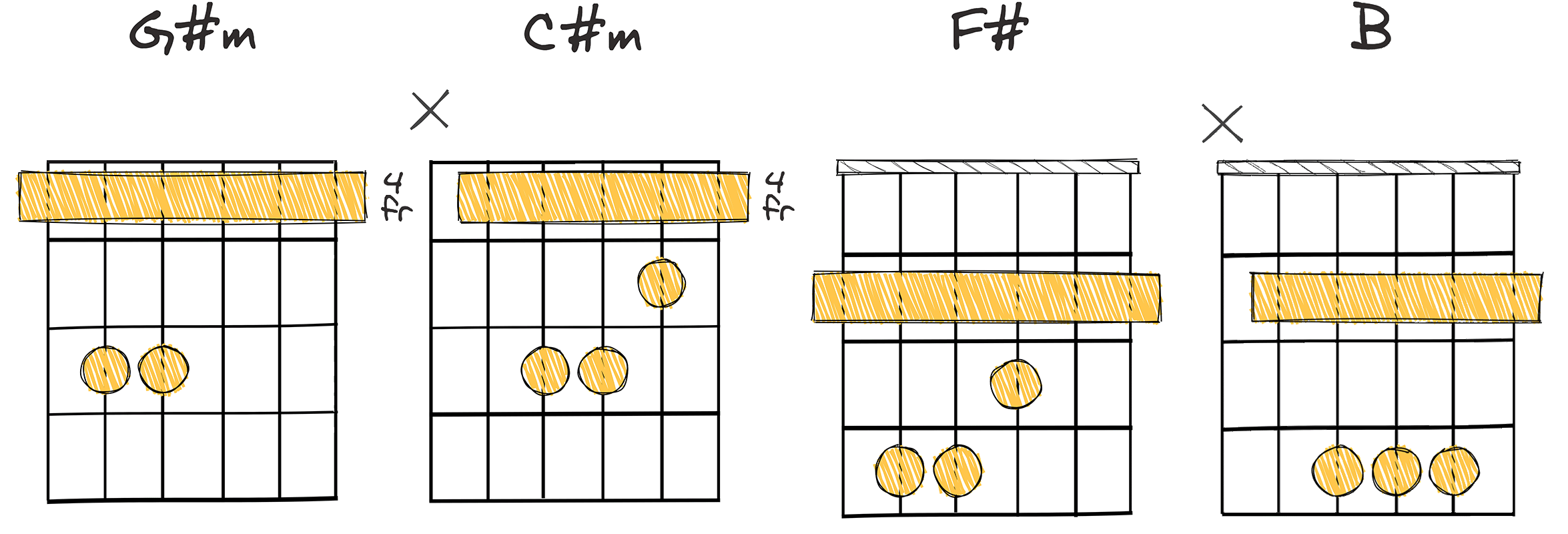
The vi-ii-V-I chord progression, also known as 6-2-5-1, carries a significant relevance in the ambit of Latin music.
Rightly positioned as our fifth chord progression, this progression has a riveting history and ubiquitous presence in the world of Latin tunes.
It’s hard to discuss Latin music without acknowledging this harmonic combination, which owes its birth to Jazz and has been adopted in a significant number of Latin genres, including Salsa, Bolero, and Son, among others.
The vi-ii-V-I progression might not be the easiest for beginners, but for those playing at an intermediate level, it can add a new dimension to their music.
This chord progression is also prevalent in boleros, where serenaders express their tales of love.
Using the 6-2-5-1 progression with the G#m – C#m – F# – B (Key of B major) can create an exciting musical journey that speaks volumes about the mystique of Latin music.
The powerful string of G#m – C#m – F# – B played in the 6-2-5-1 progression can be found in many Latin classics, breathing life into the pulsating beats and passionate vocals.
The energizing vibrancy of this progression is also why it has been adopted quite widely in the realm of Latin Jazz.
Many might argue it is the structured unpredictability of the progression that adds to its thrilling charm.
Also, the rhythmic freedom it provides has made it quite popular among Latin Jazz improvisers.
Undoubtedly, the vi-ii-V-I progression has become an integral part of Latin music’s rhythmic DNA, contributing to its vibrant and captivating aura.
Though the journey of this progression from Jazz to Latin music might seem unexpected, it is this very journey that has culminated in some of the most iconic and fondest loved Latin Music creations.
IV-V-I (4-5-1)
Anchoring your music in Latin rhythm, the IV-V-I soothes.
The IV-V-I progression, also known as the dominant resolution, is a common chord progression in Latin music known for its upbeat and lively sound. Its invigorating tonal movement from the subdominant to the dominant, resolving to the tonic, brings about an exciting rhythm which is the backbone of many catchy tunes.
- Difficulty: Easy
- Example: F – G – C (Key of C major)
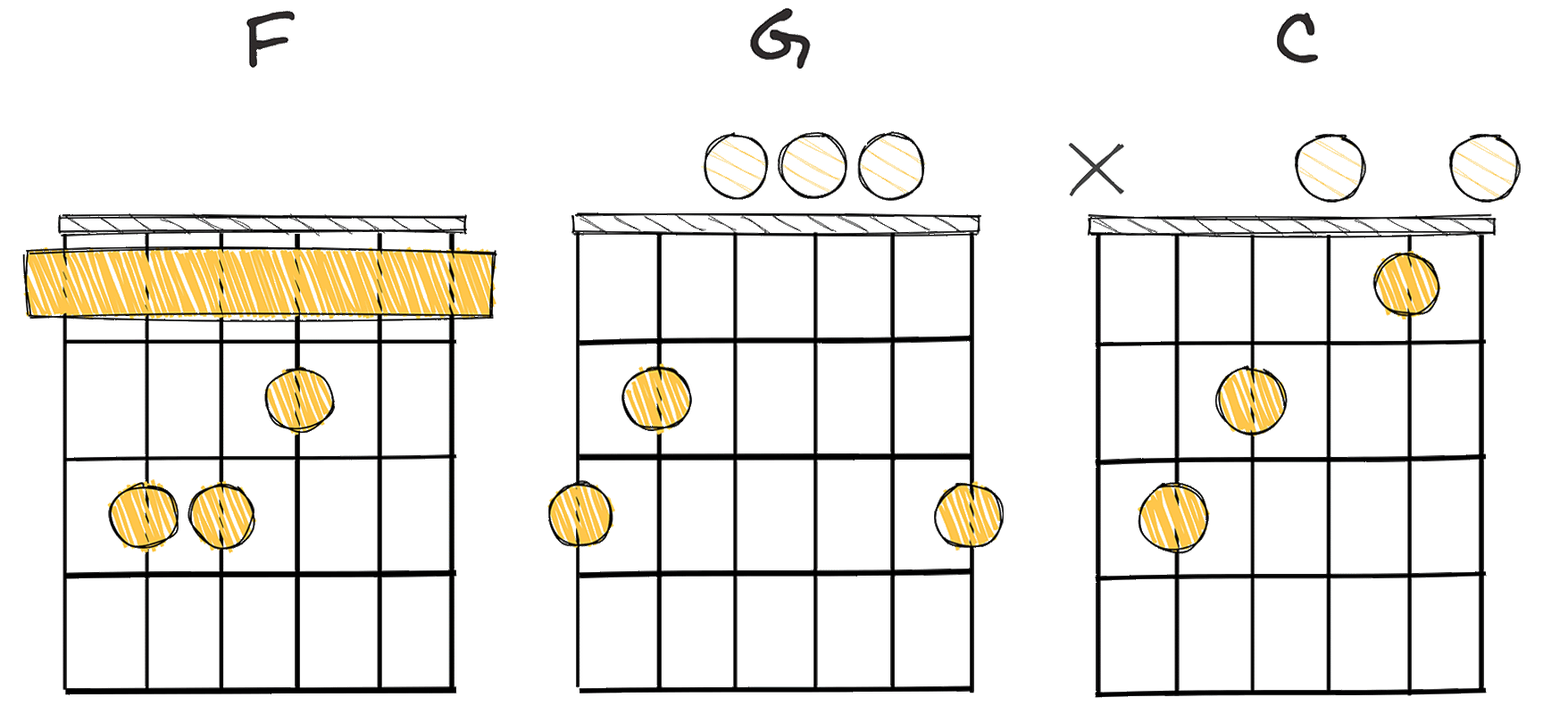
One staple in Latin music that has helped bring its iconic flavor to the mainstream is the chord progression IV-V-I (4-5-1).
This sequence is prevalent in many genres, but it is particularly defining in Latin music, helping create that irresistible, toe-tapping rhythm and warm, inviting melody we all know and love.
Without diving too much into the technical aspect of music theory, let’s remember that a chord progression is a series of chords played in a sequence.
They provide the harmonic foundation for the melody and rhythm to build upon, contributing significantly to the song’s mood and emotional impact.
The IV-V-I progression is simple yet effective, composed of three chords in the key of C major, these chords are F (the fourth), G (the fifth), and C (the first).
This progression resolves to the tonic, creating a sense of resolution and completeness, making it ideal for catchy and memorable hooks.
The interesting aspect of this particular chord progression is its versatility.
While it carries a distinctive Latin flavor, the IV-V-I sequence can be found across multiple genres, from pop to rock, reggae, and more.
Its basic nature makes it easy to incorporate into a variety of musical styles, contributing to its wide-spread popularity.
The IV-V-I progression has a historical significance in Latin music.
Rooted in traditional music structures from Latin America, this progression has been utilized for centuries, and it is far from being outdated.
Whether used in a traditional salsa piece, a Spanish ballad, or a modern pop song with Latin influences, it has stood the test of time.
The progression is also an excellent learning tool for beginners.
Since it’s comprised only of major chords, it’s pleasant to the ear and relatively easy to master on guitar, piano, or any other chordal instrument.
This makes it an attractive progression for budding songwriters and musicians to experiment with and learn.
What makes this progression remarkably Latin is not just its roots or historical context, but how it’s applied in typical Latin genres like salsa, rumba, and mariachi.
The rhythms, accents, and tempo used with IV-V-I can create a sound that transports us vividly to the tropical landscapes, bustling cities, or serene beaches of Latin America.
Melodies crafted with the IV-V-I progression are often catchy and memorable.
ii-IV-V-I (2-4-5-1)
Invigorating progression infusing Latin flavor into your sonic creations.
The ii-IV-V-I chord progression, also known as 2-4-5-1, is a common pattern in Latin music that brings a distinctive flavor and rhythm. This progression creates a bright, uplifting sound, and is often used to mark the ending of a phrase in a piece of music, making it an essential tool for any aspiring Latin music composer.
- Difficulty: Intermediate
- Example: Em – G – A – D (Key of D major)
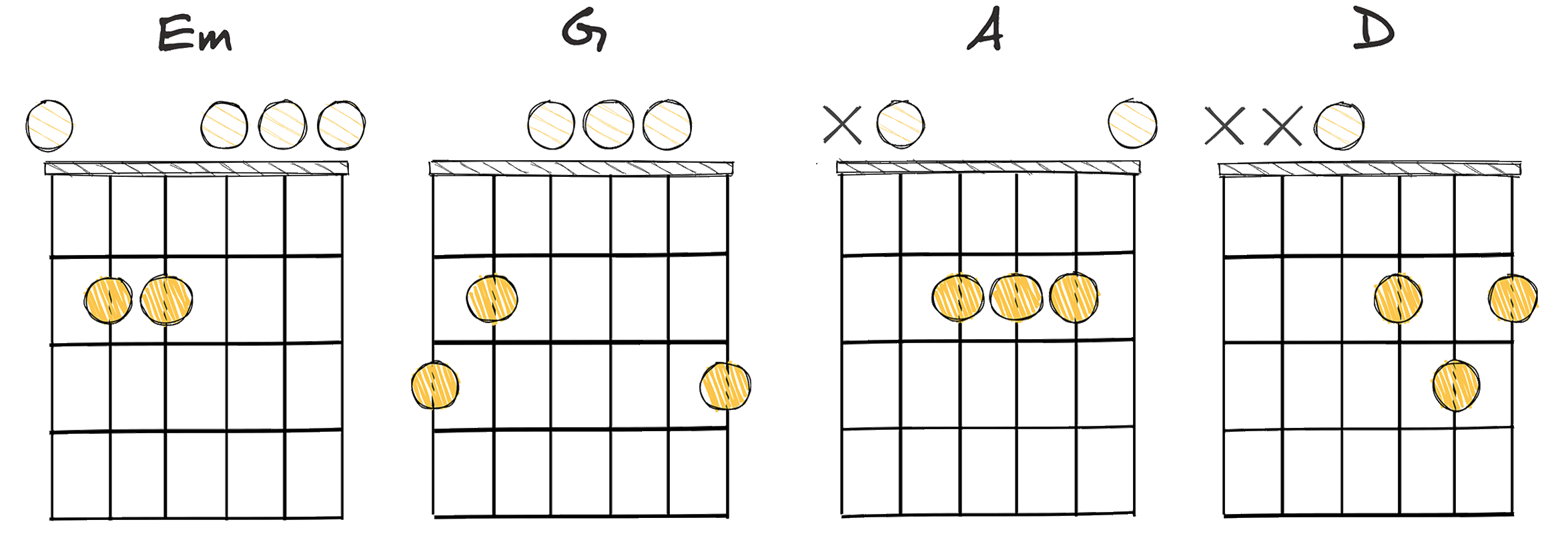
When it comes to Latin music, a critical element that adds to its unique sound is the specific chord progressions it employs.
One such progression is the ii-IV-V-I (2-4-5-1) progression, known for introducing a special flavor to the music.
Interestingly, the ii-IV-V-I progression features prominently throughout the history of Latin music.
It has been used extensively, defining some of the most iconic songs in the genre.
While being intermediate to play, this progression always contributes to a vibrant, rhythmic soundscape emblematic of Latin tunes.
Songs like “Guantanamera” demonstrate the potential of the ii-IV-V-I progression.
In this specifically, the progression breathes life into Fernandez’s musical masterpiece, resulting in a catchy tune that remains etched into the annals of Latin music.
Understanding the importance of the ii-IV-V-I progression in music theory is crucial.
As a modulating sequence, it assists in transitioning the music from one key to another, which makes songs more colorful and dynamic.
This is primarily because the ii-IV-V-I progression has a ‘circular’ quality that can perpetually loop over the entirety of a song.
This gives musicians the room to experiment with different melodic ideas over the top of the progression.
The ii-IV-V-I progression is also very versatile.
It can be employed in a variety of Latin sub-genres, be it Salsa, Bolero, or Cha Cha, this particular progression creates the distinctive Latin sound that is universally recognized and loved.
Furthermore, many musicians have been attracted to this progression’s fluidity, which allows the chords to transition smoothly from one to another.
This provides an easier playing experience for musicians while simultaneously creating a compelling musical output.
Another noteworthy aspect of this progression is that it adheres to a pattern established by the established principles of Western music theory.
Starting with the minor ii chord, proceeding to the major IV and V chords, and resolving on the major root I chord establishes a clear tonal center.
The ii-IV-V-I progression creates a sense of resolution on the I chord, giving the song a feeling of a satisfying conclusion, even though it may keep looping in the song structure.
This makes it a suitable progression for sections of the song where a melodic tension-release dynamic is desired.
Lastly, the ii-IV-V-I progression, while known for its use in Latin music, has transcended the genre over the years.
Not only is it observed in Latin-influenced pop songs, but it is also increasingly noticeable in rock and blues genres as musicians look to add some Latin flavor to their music.
As you can see, the ii-IV-V-I progression is more than just a chord sequence, It presents vast untapped potential for musical creativity, and remains an integral part of Latin music’s unique sound.
In conclusion, taking the time to understand, appreciate and master the II-IV-V-I chord progression can deeply enhance a musician’s ability to play Latin music and broaden their overall musical understanding.
IV-I-ii-V (4-1-2-5)
A vibrant chord route energizing your music with Latin flair.
The IV-I-ii-V (4-1-2-5) progression, ubiquitous in Latin music, ushers in an effervescent, rhythmic charm to the composition, adding a unique sultry allure. This harmonic sequence facilitates a smooth cycle of fifths transition which can impart a groove and a sense of resolve to your music, thus making it a staple in not only Latin, but also jazz, pop, and classical arrangements.
- Difficulty: Intermediate
- Example: Bb – F – Gm – C (Key of F major)
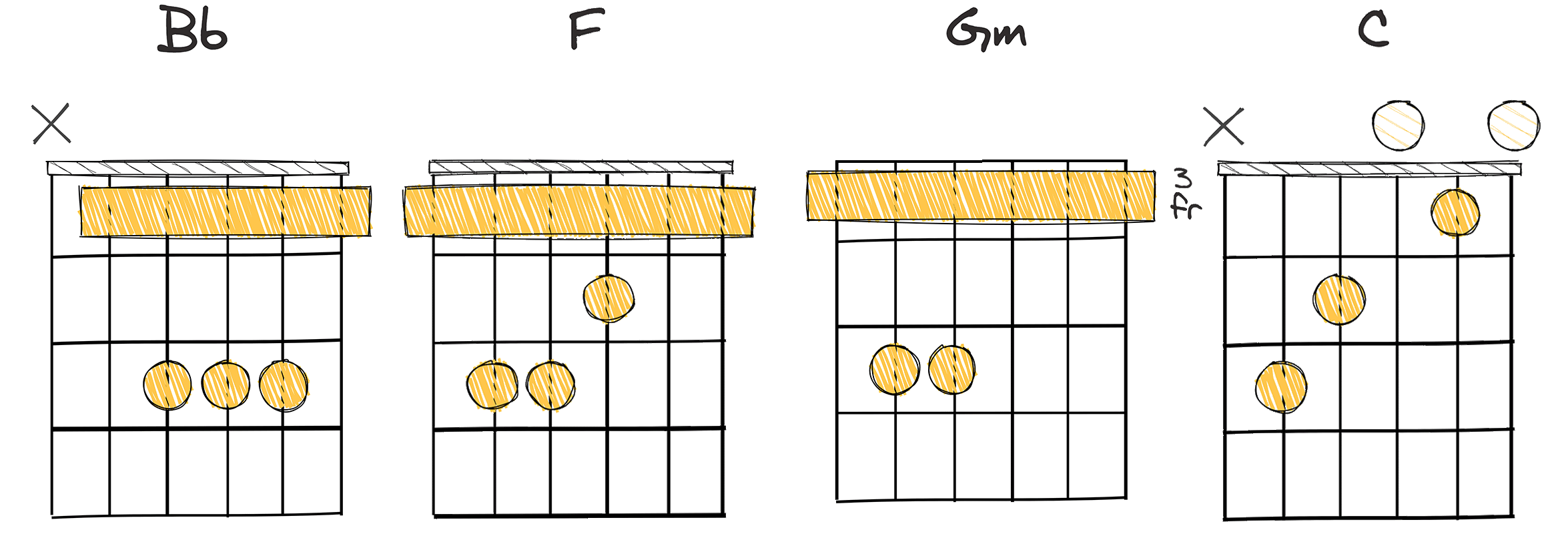
The chord progression IV-I-ii-V (4-1-2-5) has an invigorating rhythm that has engulfed various sectors of music composition, particularly within Latin music.
Originating from a blend of African, European, and indigenous traditions, Latin music has a rich history and offers a complex web of sounds and rhythms.
Embodying the true essence of Latin sound, the IV-I-ii-V chord progression is known for its vivacity, often complementing the vibrant dance styles associated with this music genre.
Deemed to be of an Intermediate level, this progression has sparked creativity among musicians and composers, serving as a colorful foundation for countless Latin songs.
The diversity and flexibility of Latin music are apparent in its chord progressions and their application across musical genres.
The IV-I-ii-V progression integration has lent itself to producing Latin music with a flair of sophistication while maintaining its stimulating and dynamic beats.
The IV-I-ii-V progression is all about balance, with each chord introducing a sense of anticipation that keeps listeners engaged and connected to the music.
This musical storytelling has made this progression so popular amongst Latin music.
Further exploration of IV-I-ii-V progression reveals that it offers a harmonic rest that settles itself beautifully within a song, helping mold Latin music’s overall aesthetics.
Understanding and utilizing this progression is key to leveraging the resonating Latin sound, furthering the richness of musical experiences it offers.
vi-V-IV-iii (6-5-4-3)
This progression injects a thrilling, Latin-inspired musical journey.
This vi-V-IV-iii chord progression introduces a distinctive touch to your music, incorporating a Latin flavor. The sequence begins with a minor chord which adds a slight melodic tension, before transitioning through major chords, culminating in an emotional resolution with the III chord, thereby creating an exotic and lively mood characteristic of Latin music.
- Difficulty: Intermediate
- Example: Am – G – F – Em (Key of C major)
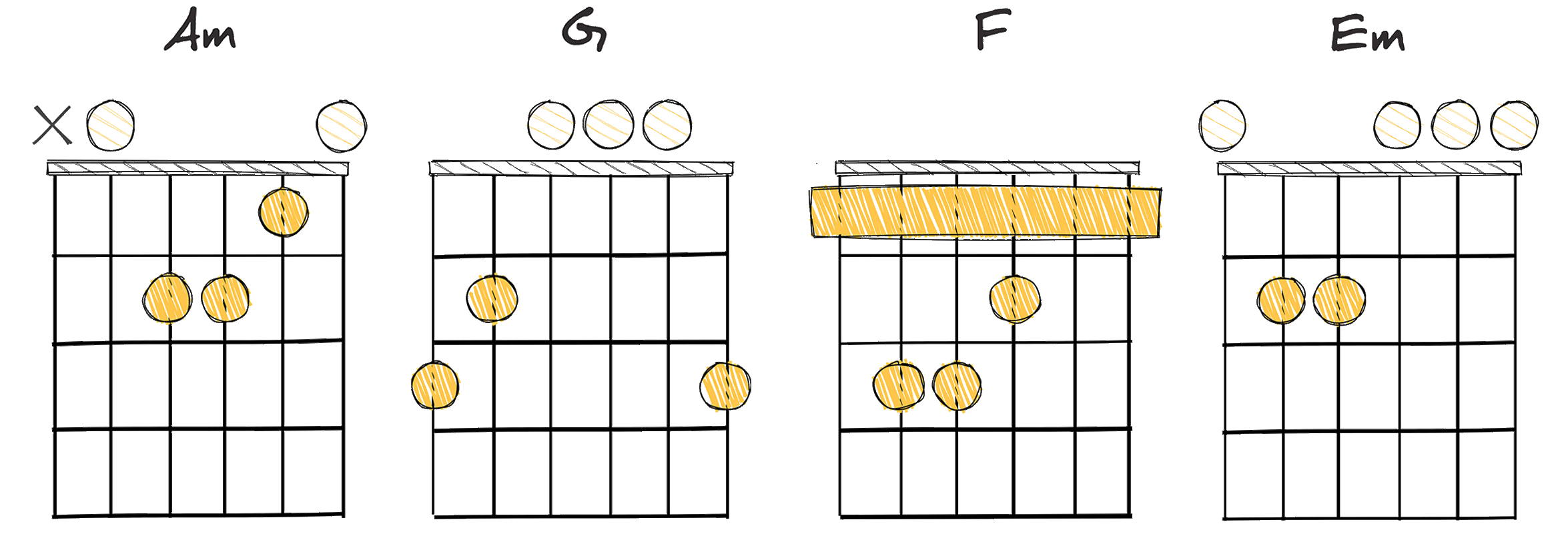
In the extensive palette of Latin chord progressions, one that especially stands out is the vi-V-IV-iii or in other words 6-5-4-3 progression.
As an intermediate chord progression, this particular sequence provides a rich platform for experimentation and can effectively add a touch of Latin flair to any musical piece.
In the context of the key of C major, this progression would look something like Am – G – F – Em.
Historically, this progression has been prominent in Latin-pop crossover hits, facilitating a rhythmic, danceable flow characteristic of Latin music genres.
The popularity of this progression may well originate from its inherent ability to introduce tension and resolution within a song, crafting an engaging musical journey.
The versatility of the vi-V-IV-iii progression allows it to embed into traditional and contemporary Latin music, making it a popular choice among many artists and composers.
The simple numeric sequence of 6-5-4-3 chords also makes it easier for musicians to transpose these progressions into different keys, further extending their creative possibilities.
Despite being categorized as an intermediate progression, its versatility and potential for artistic expression make it a worthwhile progression to learn and master for musicians of all levels.
Comprehending and incorporating these progressions into your musical repertoire will surely bestow your music with a Latin sparkle, and likely open new doors in your musical journey.
With its historical usage, musical nuance, and cultural significance, the vi-V-IV-iii progression is certainly a potent tool to enrich our sound spectrum.
By diving deeper into this progression’s unique properties and potential, you might find the key to bringing a fresh, Latin-inspired twist to your music.
So, why not try the vi-V-IV-iii progression in your next session and taste the Latin influence first-hand?
i-VII-VI-V (1-7-6-5)
Captures the soul of Latin music with an exotic embrace..
Evoking the passion of Flamenco and the rhythmic allure of salsa, this progression features the chords Dm – C – Bb – A. The interplay between minor and major chords creates a narrative full of emotion, warmth, and tension, much like a Latin dance that sweeps you off your feet. The journey from the tonic minor Dm to the dominant major A captures an exotic charm, reminiscent of a balmy night in a lively Latin town square.
- Difficulty: Intermediate
- Example: Dm – C – Bb – A (Key of D minor)
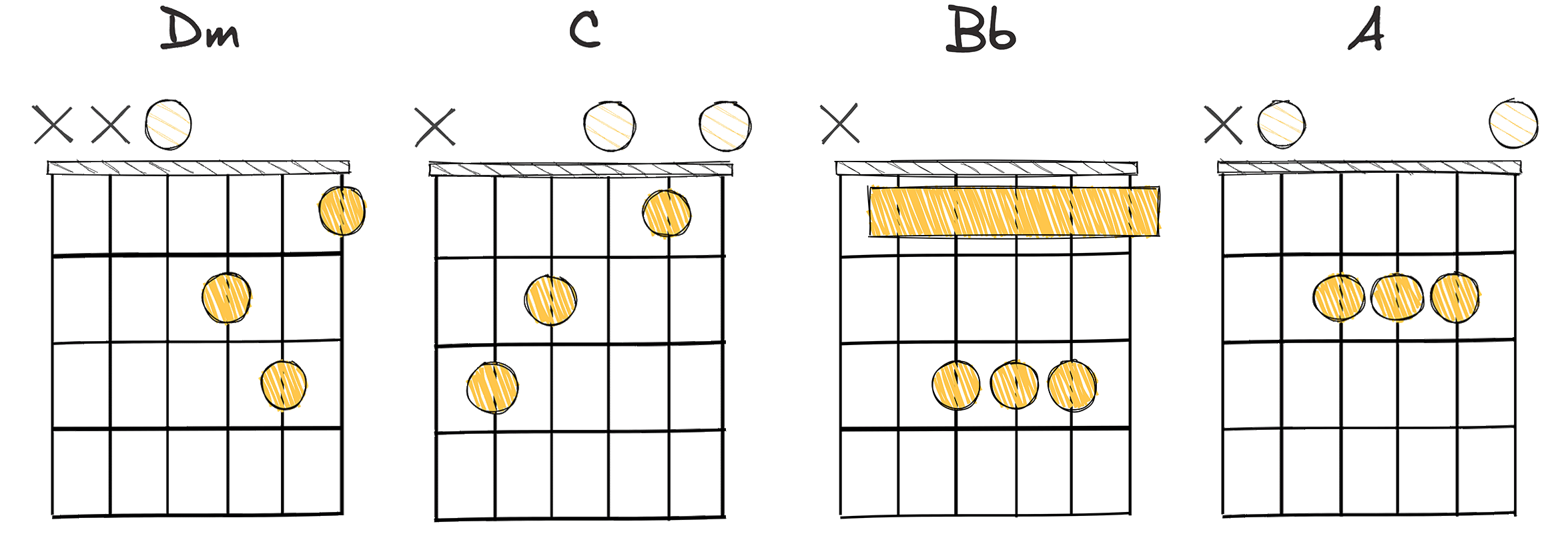
Adding a touch of exotic romance to your Latin music compositions is easy with the enchanting i-VII-VI-V chord progression that blends tradition and novelty into your melodies.
Historically, this progression has swayed not only through the world of Latin music but also found its way into genres that crave a touch of passion, underscoring its multifaceted and emotion-laden character.
At its core, the i-VII-VI-V chord progression is woven from the ‘i’ chord (first chord in a minor key) to the ‘VII’ chord (seventh chord in a major key), gliding into the ‘VI’ chord (sixth chord in a major key), and culminating in the ‘V’ chord (fifth chord in a major key).
This particular sequence has danced through countless compositions, cementing its status as a compelling voice in the musical lexicon.
Although it may be regarded as a unique progression, the i-VII-VI-V is abundant in expressive possibilities and offers a wide stage for innovation, experimentation, and heartfelt communication.
In a key like D minor, this progression would be portrayed by Dm – C – Bb – A.
Whether in the key of D minor or any other minor key, an intricate understanding of the chords and their interplay within the scale’s frame is vital to unlocking the full charm of this progression.
Mastering the i-VII-VI-V requires combining music theory knowledge with an instinct for creativity and emotional resonance.
These progressions strike a chord with audiences today due to their inherent fusion of longing and celebration, weaving a musical tale that feels both adventurous and intimately familiar.
The i-VII-VI-V opens a world of musical possibilities, beckoning composers to explore, adapt, and innovate, infusing fresh spirit into a progression with timeless Latin allure.
The i-VII-VI-V chord progression is a beautiful homage to the complexity of simplicity and the boundless opportunities of four chords, serving as a path to the musical wanderlust that transcends styles, cultures, and epochs.
I-IV-V (1-4-5)
This V-IV-I progression delivers a tantalizing salsa flair to compositions.
The V-IV-I progression is a classic sequence in Latin music, offering a rhythmic and harmonious foundation. Traditionally, this progression moves from the dominant chord (V) to the subdominant chord (IV), resolving in the tonic chord (I), providing a beautiful and melodious resolution in the composition.
- Difficulty: Easy
- Example: A – D – E (Key of A major)
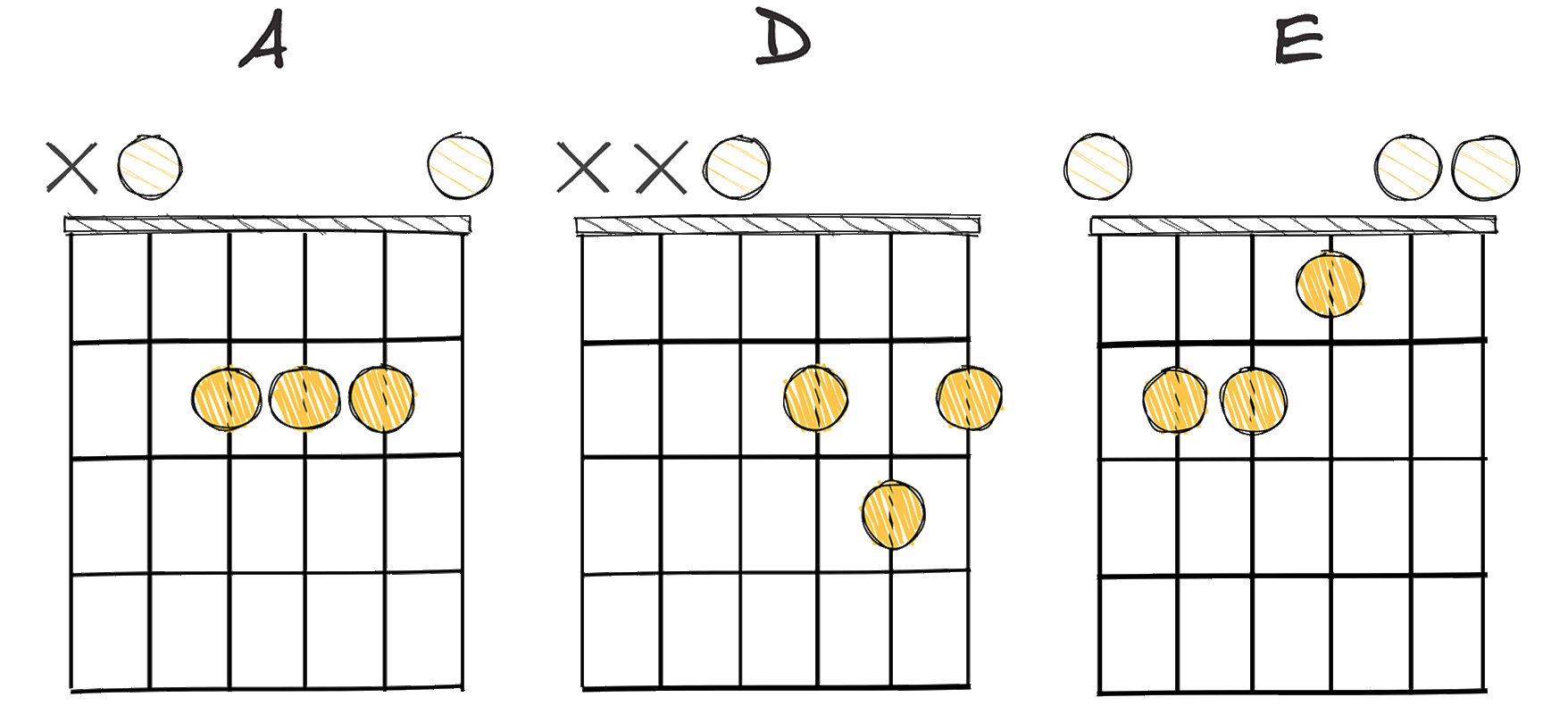
The progression I-IV-V, that soul-stirring trio of chords, resonates deeply with the cultural tapestry of Latin music.
It’s like a dance between harmony and melody, and in the case of the iconic song “Guantanamera,” it creates a profound sense of familiarity and warmth.
Here, the I-IV-V progression isn’t just a sequence of chords; it’s a vibrant painting of emotions, capturing the essence of Cuban spirit and simplicity.
The song gently weaves this progression into its fabric, invoking images of the rolling Cuban countryside and the poetic grace of José Martí’s verses.
Each chord resonates like a gentle touch, where the tonic (I) speaks of home, the subdominant (IV) explores, and the dominant (V) passionately calls back to the root.
Together, they form a melodious journey that transcends mere music, offering a glimpse into the very soul of Latin culture.
The I-IV-V progression in “Guantanamera” isn’t just a musical technique; it’s a lyrical dance that bridges the human heart with the rhythmic beauty of life.
This progression is widely easy to play.
Practical to execute on any instrument, it offers creative flexibility and is fairly straightforward to incorporate into a musician’s composition.
The reason behind its simplicity lies in the inherent structure of the progression itself.
When we take the progression in A Major scale, the chords transform into A-D-E.
You can easily play these chords on a guitar, piano or any instrument of your choice, which makes this progression a favorite among musicians, especially for beginners.
Musicians over the globe leverage this progression to bring out the potency of Latin feel into their works.
The attractive quality of this progression lies in the possibility of variation it offers.
Though artists have religiously used it in the traditional way, the possibilities for variation and innovation are endless.
Used in right nuances, I-IV-V will sound bolder with a stronger musical statement.
Through this progression, you invite the listeners into a wall of sound they can’t resist.
I encourage you to try out this musical progression on your own.
Familiarize yourself with the sound and feel of it, and then dare to venture out and experiment with changing the order or flipping the quality of the chords around.
I-vi-ii-V (1-6-2-5)
This progression infuses Latin flair into music with its harmonic rhythm.
The I-vi-ii-V chord progression is a common sequence used in Latin music, characterized by a change from the root chord to the submediant, then to the supertonic, and finally the dominant. It’s renowned for its rhythmic and melodic appeal that brings lively and energetic sounds, typical of Latin genres, thus providing a great way to add some spicy flavor to your music compositions.
- Difficulty: Intermediate
- Example: C – Am – Dm – G (Key of C major)
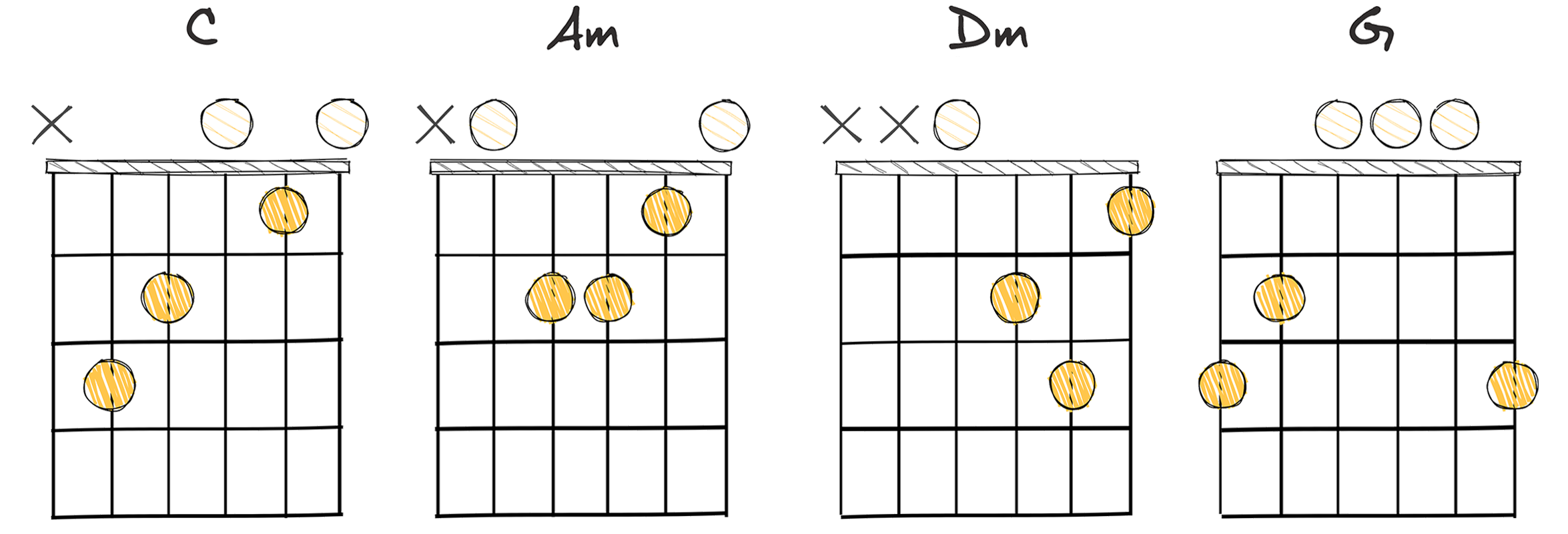
The I-vi-ii-V (1-6-2-5) chord progression offers a delightful mix of melodious harmony and captivating rhythm, both integral elements in the creation of Latin music.
Originating from the romantic era of Latin music, this four-chord progression gained fame for its ability to produce a distinctive sound that evokes intense emotions and nostalgia.
It’s worth noting that the I-vi-ii-V progression is intermediate in its complexity of execution, requiring a fair grasp of chordal understanding and instrument manipulation.
Despite this, many musicians, both amateur and professional, find joy and intrigue in mastering this progression due to its melodious charm.
Characterized by a descending bass, the I-vi-ii-V progression substantially contributes to the rhythmically dynamic and passionately expressive nature inherent to Latin music.
As the above statement clarifies, one of the pivotal characteristics of the I-vi-ii-V chord progression is its descending bass.
Each chord in the progression, starting from the tonic (I), to the relative minor (vi), and then moving to the supertonic (ii), ending with the dominant (V), sequentially descends in its tonality, creating a harmonious cascade of sounds.
This essential movement of the chords creates a pulsating rhythm that plays a significant role in shaping the engaging character of Latin music.
Songwriters and musicians have utilized the I-vi-ii-V progression widely across various compositions, appreciating its capacity to lend an appealing rhythmic structure and melodic harmony.
Exploring further, the versatility of the I-vi-ii-V progression allows it to be applied across diverse musical styles beyond Latin, enriching their melodic and rhythmic features.
With its historical roots, melodious charm, and rhythmical sophistication, the I-vi-ii-V progression significantly spices up the landscape of musical compositions.
vi-IV-I-V (6-4-1-5)
This progression creates a nostalgic and emotional Latin music resonance.
The vi-IV-I-V progression in Latin music is known for evoking a passionate, sultry mood, often associated with genres such as salsa, tango, and samba. This progression, starting on the 6th degree of the diatonic scale, delivers an inviting sense of intrigue and dynamism, offering a fresh and vibrant take on traditional chord progressions.
- Difficulty: Easy
- Example: Am – F – C – G (Key of C major)
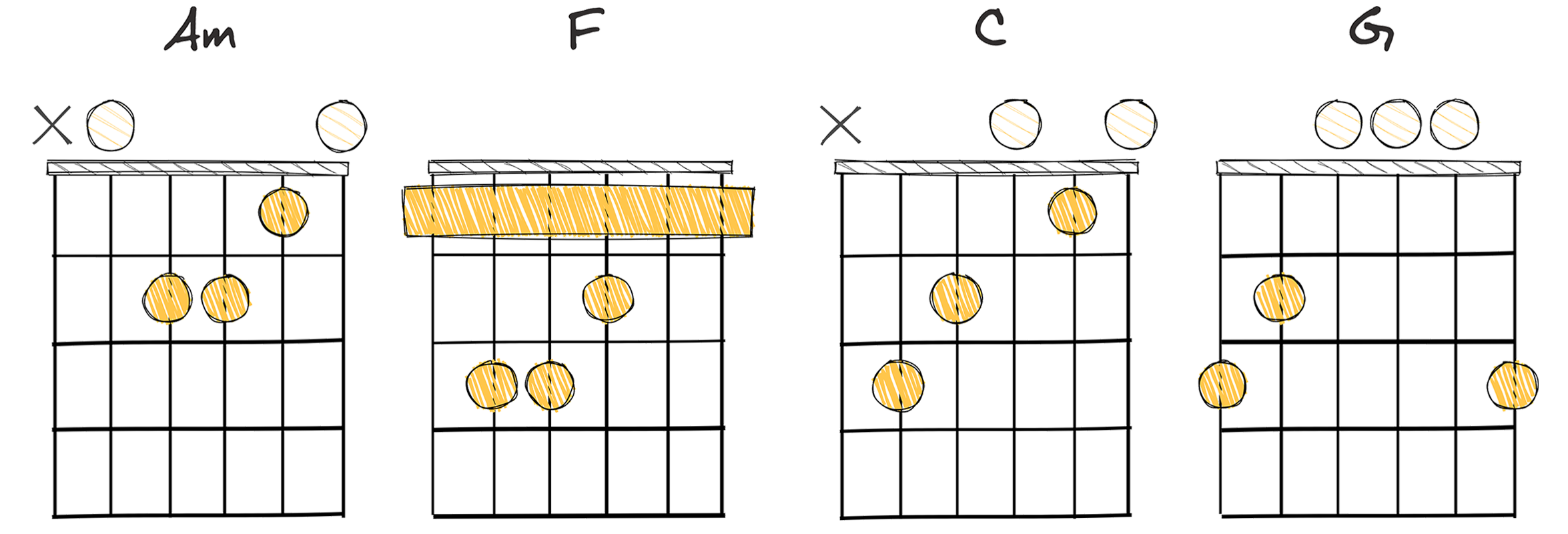
When you delve into the world of Latin music, you may come across a variety of intriguing harmonic patterns and chord structures that give the genre its unique flavor.
One such commonly used progression is the “vi-IV-I-V” or “6-4-1-5” progression, which holds a strong footing on Latin music landscape.
This progression is not limited to Latin music alone; it’s a staple in numerous genres ranging from rock to pop, showing its versatility and universal appeal.
The “6-4-1-5” progression is known for its smooth, flowing transitions and undeniable harmonic comfort that can inject a delightful touch into your composition.
Historically speaking, this progression has been used since the Baroque period, having stood the test of time with its simplistic yet elegant structure.
Latin music has seen extensive use of the 6-4-1-5 progression, contributing significantly to its characteristic rhythm and melody patterns.
The usage of this progression in Latin music can be traced to its rhythmic, harmonic, and melodic characteristics, perfectly aligning with the genre’s essence.
Inherently, it easily facilitates easy movement between chords, therefore it’s effortless for musicians to play.
This user-friendliness is accompanied by an ability to create an array of mood variations, thereby bringing a certain temperament to the overall composition.
The “vi-IV-I-V” or “6-4-1-5” is an easy-to-play powerhouse which, while being firmly rooted in Latin music, extends its influence far beyond one genre.
I-ii-V7-I (1-2-5-1)
A classic Latin rhythm staple enhancing any piece’s harmonic interest.
The I-ii-V7-I progression, also known as 1-2-5-1, is a unique and iconic sequence of chords often found in Latin music styles. It adds an exciting rhythmic flavor and harmony to a composition, offering a distinct Latin-inspired groove and enriching the overall musical experience.
- Difficulty: Intermediate
- Example: C – Dm – G7 – C (Key of C major)
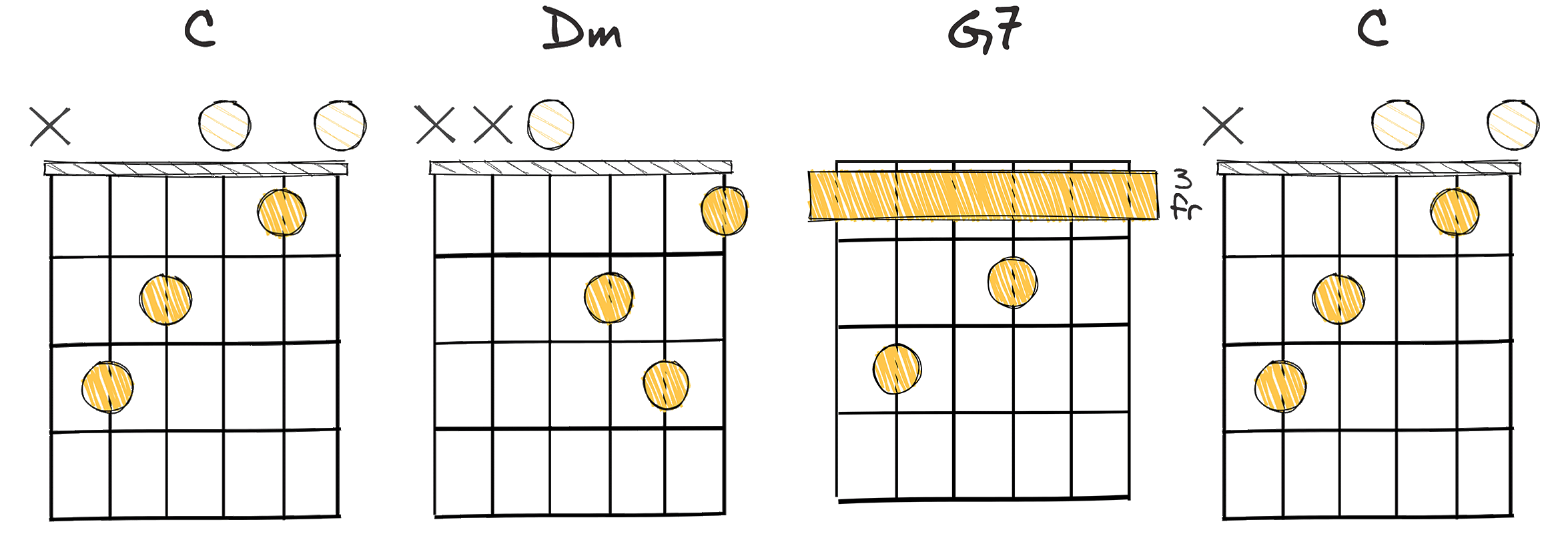
The Latin chord progression I-ii-V7-I (1-2-5-1) is an important rhythmic structure that adds an undeniable vibrancy to all kinds of music using the Chords C – Dm – G7 – C (Key of C major).
This chord progression is an inherently warm style, intensifying the richness and depth of the musical composition.
Following this chord progression, there is a sense of the music cycling back to its root, creating a predictable and pleasing pattern to the ear.
The chord transition also allows for improvisation, giving musicians the opportunity to add their unique twist to the musical piece.
The I-ii-V7-I progression was not developed in isolation; rather, it is deeply rooted in Latin musical history and tradition.
Originating from the common practice period, it has been widely adopted in various Latin music genres, from salsa to bossa nova, giving them the signature Latin vibrancy we all love.
It’s been played by great Latin musicians over the years, adding a flavorful touch to their music.
The fact that this chord progression is intermediate to play does not take away from its significance and impact in producing melodious tunes.
On the contrary, it means that with a little practice, even newer musicians can incorporate it into their music and add some of that Latin flair.
The magic lies not just in playing the chords themselves but in the way they are harmoniously transitioned.
In essence, learning to play the I-ii-V7-I Latin chord progression is about mastering the chords and understanding their musical interaction.
This understanding ultimately contributes to creating a piece of music that resonates with the true Latin spirit.
vi-IV-I-V (6-4-1-5)
A soulful, rhythmic dance, weaving emotions and harmony into a compelling musical narrative.
The vi-IV-I-V progression in D major starts with the reflective B minor, creating a poignant emotional landscape. It then transitions to G major’s brightness and D major’s comforting resolution, forming a harmonious blend. Culminating with A major, this progression weaves a rhythmic dance of emotions, making it a compelling and universal musical narrative.
- Difficulty: Intermediate
- Example: Bm – G – D – A (Key of D major)
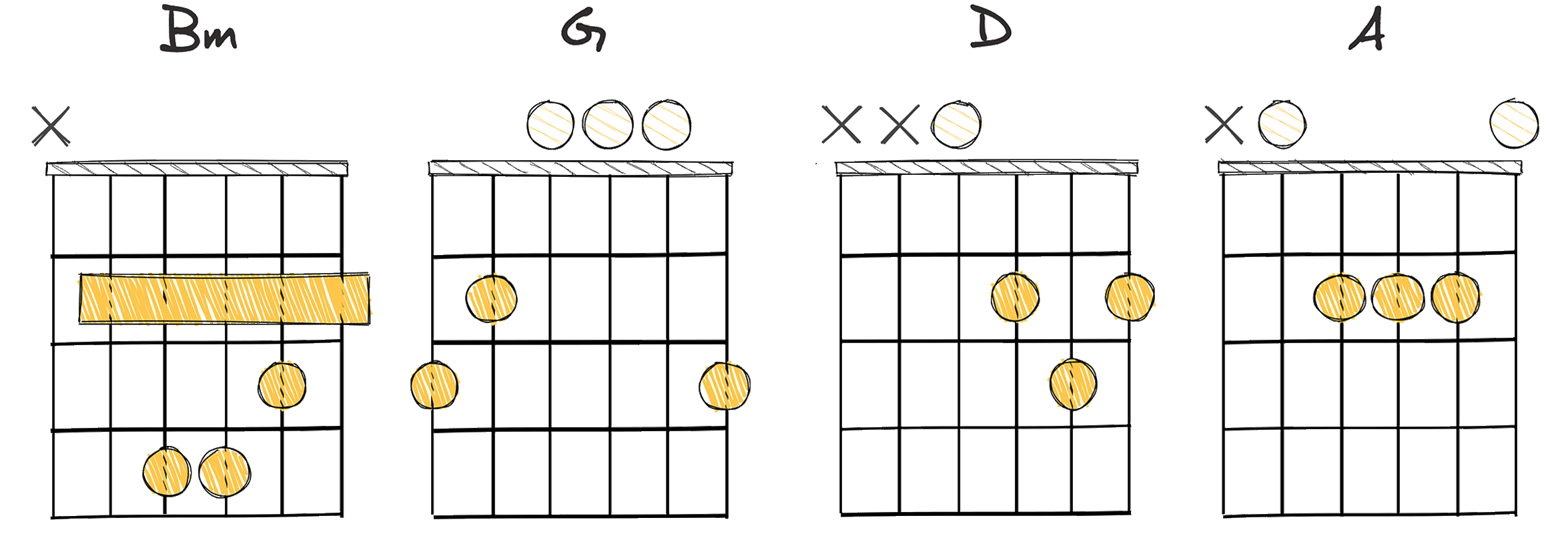
The progression Bm – G – D – A in the key of D major forms the recognizable vi-IV-I-V pattern, a musical sequence that has been cherished across various genres for its emotive power.
In this progression, B minor (Bm) starts the journey with a soul-stirring touch, the minor chord’s moody character hinting at a deep and reflective beginning.
G major (G) then steps in as the IV chord, like a ray of sunlight breaking through clouds, bringing a sense of optimism and brightness.
The progression finds its heart in D major (D), the I chord, resonating with a feeling of resolution and stability that feels like coming home.
A major (A), the V chord, acts as the gateway back to the beginning, its dominant nature building tension and desire that beckons the listener back to the starting point.
This progression plays a central role in the megahit “Despacito” by Luis Fonsi.
It’s an enchanting dance of emotions, winding through the soulful realms of Latin music, giving “Despacito” its infectious charm and rhythm.
The vi chord sets a minor, reflective tone, creating an emotional longing that’s quickly lifted by the IV chord, a major progression that adds a glimmer of hope.
The I chord then anchors the sequence with a comforting, home-like feel, while the V chord adds an irresistible pull that brings the listener back to the start, all over again.
In “Despacito,” this progression serves as a musical storyteller, capturing the very essence of passion, romance, and the zest of Puerto Rican culture.
It’s like a gentle breeze swaying through palm trees, a rhythmic heartbeat that connects listeners to the song’s pulsing energy and sensuality.
I-IV-V-IV (1-4-5-4)
A flavorful journey through Latin harmonies, defying traditional tonal expectations.
The progression’s cyclical nature allows for a smooth transition between chords, creating a pleasing balance that can easily be paired with Latin percussion or guitar techniques. Its inherent versatility and soulful resonance make it a valuable tool for musicians aiming to capture the lively spirit and rich cultural essence of Latin musical traditions.
- Difficulty: Intermediate
- Example: E – A – B – A (Key of E major)
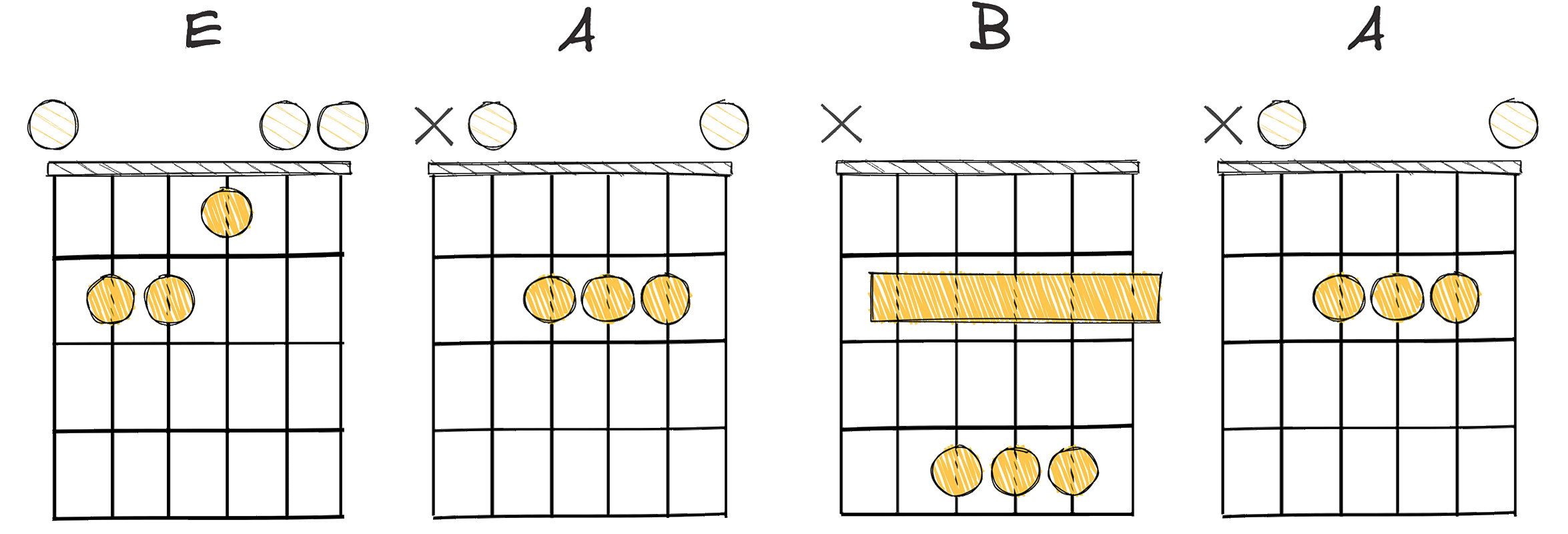
Historically speaking, this progression has found its place within Latin music and across various musical landscapes, echoing its dynamic and rhythmic-driven essence.
At its core, the I-IV-V-IV chord progression is shaped by a transition from the ‘I’ chord (first chord in a major key) to the ‘IV’ chord (fourth chord in a major key), progressing to the ‘V’ chord (fifth chord in a major key), and returning to the ‘IV’ chord.
This specific sequence has graced many compositions, engraving its mark in the musical fabric of different cultures and styles.
Though considered a foundational progression, the I-IV-V-IV is bursting with potential, offering wide avenues for innovation, artistic expression, and a direct connection to the listener’s emotions.
In a key like E major, for example, this progression would translate to E – A – B – A.
No matter the key, a profound understanding of the chords’ interplay and their positioning within the musical scale is vital to unlocking the full expressive power of this progression.
Mastering the I-IV-V-IV requires theoretical knowledge and a feeling of rhythm and melody, particularly in Latin music.
This progression continues to touch hearts today due to its inherent dance of tension and release, weaving an energetic and soothing musical narrative.
The I-IV-V-IV presents endless creative potential, encouraging musicians to bend, adapt, and reinvent, infusing fresh vitality into a classic progression.
The I-IV-V-IV chord progression is an enduring symbol of musical simplicity yet boundless creativity.
It serves as a bridge to the musical discovery that spans across styles, traditions, and time, especially when it resonates with Latin music’s vibrant and rhythmic nuances.
IV-V-vi-I (4-5-6-1)
A soulful Latin cadence igniting passion in every musical composition.
The IV-V-vi-I chord progression, often used in Latin music, introduces a dynamic surprise to listeners as the expected resolution to the dominant is momentarily postponed, creating tension and intrigue. The progression goes from a major chord to another major, then to a minor and resolves in the tonal center, adding an appealing twist and emotional depth to the music.
- Difficulty: Easy
- Example: F – G – Am – C (Key of C major)
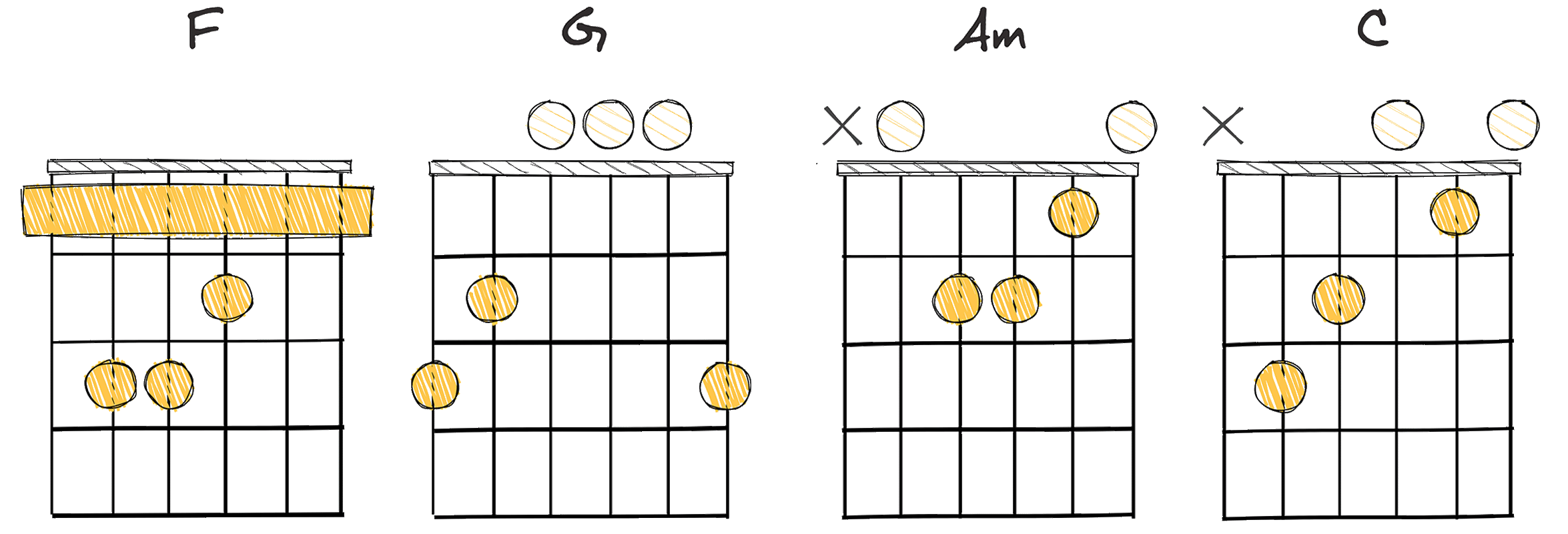
The IV-V-vi-I (4-5-6-1) progression is yet another Latin chord progression that adds a unique and compelling touch to your music.
This progression, which has a fascinating history, is not only rich in tradition but also in musical variety.
Historically, the IV-V-vi-I progression has been expressed in various music genres.
It became popular due to its emotional depth and diversity, and continues to be favored among musicians.
Latin music, with its distinctive rhythms and harmonic structures, often employs the IV-V-vi-I progression to create richly textured melodic lines.
This progression’s unique features allow musicians to express a range of emotions, from joy to sorrow.
Moreover, the versatility of IV-V-vi-I progression adds a touch of complexity to Latin tunes.
The progression structure of IV-V-vi-I easily fits in with other chord progressions, thus making it a flexible choice for various pieces of music.
Interestingly, it is quite easy to play on various musical instruments which makes it a favorite among musicians of all skill levels.
The Bottom Line
Ultimately, it’s apparent that these chord progressions hold significant importance in music composition across genres.
They create the backbone of a piece, providing a sense of direction and movement that enhances the emotional impact of the melody.
By mastering these conventions and understanding the moods and tensions they evoke, composers have the tools to create compelling and engaging music.
This reaffirms the centrality of chord progressions not only in defining harmonic structure, but also in shaping a piece’s overall narrative and emotional trajectory.
In love with guitars, and gear; expert in all things music! Been writing about guitars for about 5 years and counting. Born in the ’90s. Alma Mater: University of Havana. Always curious, trying to understand the world. #TeamFender




